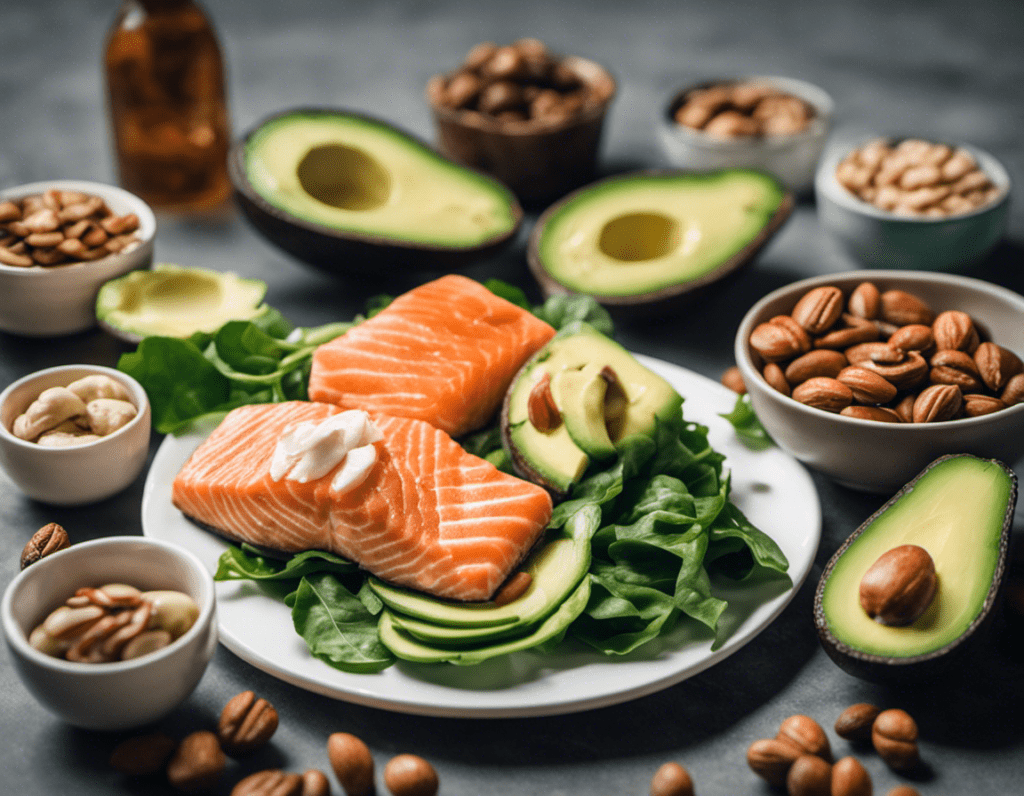Do you want to stay in ketosis and reap the benefits of this metabolic state? Understanding the role of macros is essential.
By tracking and adjusting your macronutrients, you can ensure you’re consuming the right foods to maintain ketosis.
In this article, we’ll explore the science behind ketosis and provide practical tips and tricks to help you stay on track.
Get ready to discover the power of macros in achieving your goals and serving your body in the best way possible. Let’s dive in!
Key Takeaways
- Maintaining ketosis requires monitoring carbohydrates, proteins, and fats.
- The standard ketogenic diet (SKD) consists of 75% fat, 20% protein, and 5% carbohydrates.
- Carbohydrate intake should be limited to less than 50g per day.
- Fat intake should be high, while protein intake should be moderate.
Understanding Ketosis and its Benefits
To understand ketosis and reap its benefits, you need to know how macros play a role in staying in ketosis. Ketosis is a metabolic state where your body uses fat for fuel instead of carbohydrates. Unlike other low carb diets, which may focus on restricting overall calories, ketosis focuses on limiting carbohydrate intake to induce a state of ketosis. This means that you need to be mindful of the types and amounts of carbohydrates you consume.
A common misconception about ketosis is that it is a high protein diet. While protein is an important macronutrient, consuming too much can actually hinder ketosis. This is because excess protein can be converted into glucose through a process called gluconeogenesis, which can kick you out of ketosis.
Transition: Now that you understand the basics of ketosis and its common misconceptions, let’s delve into the role of macronutrients in staying in ketosis.
The Role of Macronutrients in Ketosis
You can maintain a state of ketosis by carefully monitoring your intake of carbohydrates, proteins, and fats. The key to staying in ketosis is to consume the right macronutrient ratios that promote fat burning and ketone production. In general, a standard ketogenic diet (SKD) consists of about 75% fat, 20% protein, and 5% carbohydrates. However, these ratios can vary depending on individual needs and goals. To help you understand the macronutrient breakdown, here’s a simple table:
| Macronutrient | Grams per Day |
|---|---|
| Carbohydrates | Less than 50g |
| Protein | Moderate |
| Fat | High |
Tracking and Adjusting Your Macros
By carefully monitoring your carbohydrate, protein, and fat intake, you can track and adjust your macros to maintain a state of ketosis. Here are four ways to effectively track and adjust your macros:
- Keep a food diary: Track everything you eat and drink to get a clear picture of your daily macronutrient intake.
- Use a tracking app: Utilize mobile apps that provide nutritional information and allow you to log your meals and snacks.
- Measure ketone levels: Use urine strips, blood tests, or breath analyzers to measure ketone levels and ensure you are in ketosis.
- Monitor progress: Regularly check your weight, body measurements, and energy levels to gauge the effectiveness of your macro tracking.
Choosing the Right Foods for Ketosis
Now that we’ve covered tracking and adjusting your macros, let’s dive into choosing the right foods for ketosis. When following a ketogenic diet, it’s important to focus on food options that are low in carbohydrates and high in healthy fats. This promotes a state of ketosis, where your body burns fat for fuel instead of carbohydrates. To help you with your meal planning, here is a table outlining some excellent keto-friendly food options:
| Protein | Healthy Fats |
|---|---|
| Chicken | Avocado |
| Salmon | Olive Oil |
| Eggs | Coconut Oil |
| Beef | Nuts |
Incorporating these foods into your meals will ensure you stay in ketosis and reap the benefits of this metabolic state. Now, let’s move on to some tips and tricks for staying in ketosis without feeling deprived or restricted.
Tips and Tricks for Staying in Ketosis
To successfully maintain ketosis, it’s essential to incorporate these tips and tricks into your routine.
First, meal prepping is crucial. By planning and preparing your meals in advance, you can ensure that your diet stays on track and you’re not tempted to reach for carb-filled options.
Second, consider incorporating intermittent fasting into your ketogenic lifestyle. This eating pattern involves alternating periods of fasting and eating, which can help optimize ketone production and fat burning. Start by gradually increasing your fasting window and listen to your body’s hunger cues.
Remember to stay hydrated and prioritize nutrient-dense foods.
Lastly, be patient with yourself. Staying in ketosis takes time and discipline. By implementing these strategies, you’ll be on your way to successfully maintaining ketosis and achieving your health goals.
Frequently Asked Questions
Can I consume artificial sweeteners while in ketosis?
Yes, you can consume artificial sweeteners while in ketosis. They do not have a significant impact on ketosis. However, it’s important to choose sweeteners that do not contain carbohydrates or raise blood sugar levels.
What are some common signs of being in ketosis?
Discover some delightful signs of being in ketosis, including increased energy, improved mental clarity, and appetite suppression. Embrace the amazing benefits of ketosis and revel in the remarkable results it can bring to your wellness journey.
Is it necessary to count calories in addition to tracking macros?
Counting calories is not necessary in addition to tracking macros, but it can be helpful for tracking progress. While macros focus on the types of nutrients, calories provide an overall measure of energy intake.
How long does it typically take to enter ketosis?
You’re eager to enter ketosis, and the journey can be like climbing a mountain. The ketosis timeline varies, typically taking 2-7 days. Factors like carb intake, exercise, and metabolic health influence the speed. Stay patient and committed to reach your goal.
Can I consume alcohol while following a ketogenic diet?
Yes, you can consume alcohol while following a ketogenic diet, but it’s important to choose low-carb options. Avoid sugary mixers and be aware that alcohol can slow down your progress in ketosis. Artificial sweeteners may have different effects on ketosis, so use them in moderation.
Conclusion
In conclusion, you now have a better understanding of the role macros play in staying in ketosis. By tracking and adjusting your macros, you can ensure you’re consuming the right balance of nutrients to maintain ketosis.
Choosing the right foods and making smart choices will also help you stay on track. Remember, ‘practice makes perfect,’ so don’t get discouraged if it takes time to find what works best for you.
With dedication and consistency, you can enjoy the many benefits of ketosis and reach your health goals.








